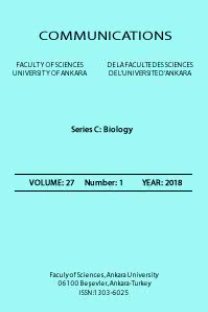The effect of lead (Pb) on the growth rates of two aquatic macrophyte species; Limnobium laevigatum (Humb & Bonpl. ex Willd) Heine and Egeria densa Planch. grown in different experimental media
aquatic pollution, macrophytes, lead, heavy metals
The effect of lead (Pb) on the growth rates of two aquatic macrophyte species; Limnobium laevigatum (Humb & Bonpl. ex Willd) Heine and Egeria densa Planch. grown in different experimental media
Aquatic pollution, macrophytes, lead, heavy metals,
___
- Carolin, C., Kumar, P.S., Saravanan, A., Joshiba, G.J., Efficient techniques for the removal of toxic heavy metals from aquatic environment: a review. Journal of Environmental Chemical Engineering, 5(3) (2017), 2782-2799. https://doi.org/10.1016/j.jece.2017.05.029
- Vardhan, K.H., Kumar, P.S., & Panda, R.C., A review on heavy metal pollution, toxicity and remedial measures: current trends and future perspectives. Journal of Molecular Liquids, 290 (2019), 111197. https://doi.org/10.1016/j.molliq.2019.111197
- Nahar, K., Sunny, S.A., & Shazi, S.S., Land use requirement and urban growth implications for the production of biofuel in Bangladesh. Forest 1350.1350 (2011), 0-92.
- Azimi, A., Azari, A., Rezakazemi, M., Ansarpour, M., Removal of heavy metals from industrial wastewaters: a review. ChemBioEng Reviews, 4(1) (2017), 37-59. https://doi.org/10.1002/cben.201600010
- Ansari, T.M., Marr, I.L., & Tariq, N., Heavy metals in marine pollution perspective-a mini review. Journal of Applied Sciences, 4(1) (2004), 1-20. https://scialert.net/abstract/?doi=jas.2004.1.20
- Lajayer, B.A., Ghorbanpour, M., & Nikabadi, S., Heavy metals in contaminated environment: destiny of secondary metabolite biosynthesis, oxidative status and phytoextraction in medicinal plants. Ecotoxicology and Environmental Safety, 145 (2017), 377-390. https://doi.org/10.1016/j.ecoenv.2017.07.035
- Kabata-Pendias, A., Trace Elements in Soils and Plants. CRC Press, Boca Raton, Florida, USA, 2000.
- Fu, F., & Wang, Q., Removal of heavy metal ions from wastewaters: a review. Journal of Environmental Management, 92(3) (2011), 407-418. https://doi.org/10.1016/j.jenvman.2010.11.011
- Nassouhi, D., Ergönül, M.B., Fikirdeşici, Ş., Karacakaya, P., & Atasağun, S., Ağır metal kirliliğinin biyoremediasyonunda sucul makrofitlerin kullanımı. Süleyman Demirel Üniversitesi Eğirdir Su Ürünleri Fakültesi Dergisi, 14(2) (2018), 148-165. https://doi.org/10.22392/egirdir.371340
- Bello, A.O., Tawabini, B.S., Khalil, A.B., Boland, C.R. and Saleh, T.A., Phytoremediation of cadmium-, lead-and nickel-contaminated water by Phragmites australis in hydroponic systems. Ecological Engineering, 120 (2018), 126-133. https://doi.org/10.1016/j.ecoleng.2018.05.035
- Güner, A., Ekim, T., Kandemir, A., Ekşi, G., Yıldırım, H., Korkmaz, H., & Menemen, Y., Resimli Türkiye Florası (Illustrated Flora of Turkey). Türkiye İş Bankası Kültür Yayınları yayını, İstanbul (2014).
- Hoagland D.R., Arnon D.I., The water-culture method for growing plants without soil. California Agricultural Experiment Station, Circular vol. 347-2, Berkeley, Calif, USA, 1950.
- Anonymous, Available from: https://www.researchgate.net/publication/ 11253164_Avoiding_Bias_in_Calculations_of_Relative_Growth_Rate:Oct. 15, 2022.
- Arán, D.S., Harguinteguy, C.A., Fernandez-Cirelli, A. and Pignata, M.L., Phytoextraction of Pb, Cr, Ni, and Zn using the aquatic plant Limnobium laevigatum and its potential use in the treatment of wastewater. Environmental Science and Pollution Research, 24(22) (2017), 18295-18308. https://link.springer.com/article/10.1007/s11356-017-9464-9
- Fernández San Juan, M.R., Albornoz, C.B., Larsen, K. & Najle, R., Bioaccumulation of heavy metals in Limnobium laevigatum and Ludwigia peploides: their phytoremediation potential in water contaminated with heavy metals. Environmental Earth Sciences, 77(11) (2018), 1-8. https://link.springer.com/article/10.1007/s12665-018-7566-4
- Dalmış, E., & Leblebici Z., Pistia stratiotes’ in Kadmiyum, Kurşun ve Nikel Içeren Sularda Büyüme Hızının Zamanla Değişimi ve Metal Akümülasyonu. Nevşehir Hacı Bektaş Veli Üniversitesi Fen Bilimleri Enstitüsü, 2016.
- Yurdakul Y.S., Egeria densa Sucul Bitkisinin Vanadyum İle Kirlenmiş Sularda Fitoremediasyon Potansiyelinin Araştırılması. Ankara Üniversitesi Fen Bilimleri Enstitüsü, (2021).
- Tangahu, B.V., Abdullah, S.R.S., Basri, H., Idris, M., Anuar, N., & Mukhlisin, M., Lead (Pb) removal from contaminated water using constructed wetland planted with Scirpus grossus: optimization using response surface methodology (RSM) and assessment of rhizobacterial addition. Chemosphere, 291 (2022), 132952. https://doi.org/10.1016/j.chemosphere.2021.132952
- Li, Y., Xin, J., & Tian, R., Physiological defence and metabolic strategy of Pistia stratiotes in response to zinc-cadmium co-pollution. Plant Physiology and Biochemistry, 178 (2022), 1-11. https://doi.org/10.1016/j.plaphy.2022.02.020
- Sudiarto, S.I.A., Renggaman, A., & Choi, H.L., Floating aquatic plants for total nitrogen and phosphorus removal from treated swine wastewater and their biomass characteristics. Journal of Environmental Management, 231 (2019), 763-769. https://doi.org/10.1016/j.jenvman.2018.10.070
- ISSN: 1303-6025
- Yayın Aralığı: Yılda 2 Sayı
- Başlangıç: 1943
- Yayıncı: Ankara Üniversitesi
New record of exotic land snail Rumina decollate (Linnaeus, 1758) in Iraq
Ragda H. AL-QAİSİ, Khansaa FARMAN
An investigation of Pseudomonas marincola to determine Pb(II) biosensor potential
Cihan BOSTANCI, Hasan NAZIR, Gönül DÖNMEZ
Kamil CANDAN, Elif YILDIRIM, Yusuf KUMLUTAŞ, Osman Sinan GÜNİSTER, Çetin ILGAZ
Kübra KARAKAŞ, Kamil Mert ERYALÇIN, Mehmet Borga ERGÖNÜL, Tahir ATICI, Sibel ATASAGUN
Copper(II) bioremoval by thermophile Cyanobacterium aponinum
Seda ŞEN, Nur KOÇBERBER KILIÇ, Gönül DÖNMEZ
